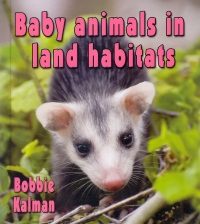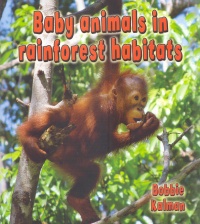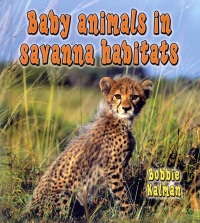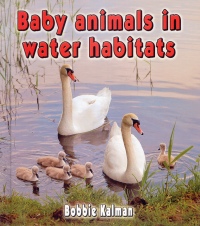| ________________
CM . . . . Volume XVIII Number 16 . . . . December 16, 2011
excerpt:
The four new additions to “The Habitats of Baby Animals” series maintain the quality and style of previous books in the series (see CM, Vol. 17, No. 41). They present good information in a relatively simple format. Young readers will benefit from the limited quantity of text compared to photos. Concepts, such as food, homes, life cycle and food chains, are explained simply with text and illustrated with beautiful photographs. Each book includes a table of contents and an index. Although the index is titled “Words to know” and “Index,” there is no glossary. The index lists a number of pages where information about topics, such as babies and food, is located. This will be useful to young researchers who may be asked to find an answer to a specific factual question. Many of the index words are accompanied by a small photo which will be a visual cue for beginning readers to lead them back to a particular topic. Words in bold throughout the text are included in the index, but without a definition. Each book begins with an explanation of what a habitat is, including identifying living and non-living components. Each book then briefly examines the distinguishing characteristics of the particular habitat that is the focus of the book. As in other books in the series, one weakness is the use of black text on dark coloured backgrounds. Sometimes white text has been used on coloured pages, but other times black text is used, making it more difficult to read. I don’t like this practice at any level but find it especially problematic in books for beginning readers. Although some information is repeated in each book (a feature that might be considered poor value for older researchers), this characteristic could be very helpful when you are guiding a group of young students through the research process for the first time. Each student can use a different book to do her/his own research, but the teacher can ask the students to locate the same information. For example, together students can find information about what a habitat is at the front of each of their books, and then they can find information about the specific habitat that they are working with, for example, land, rainforest, savanna, water, or other habitats in the series. Baby Animals in Land Habitats features baby animals that live in different places around the world, such as deserts, mountains, grasslands, temperate and tropical forests. Most of the animals are mammals but a python and an ostrich are also included. The photograph of the young bobcat with a chipmunk to eat in its mouth may be a bit more graphic that expected in books for young students, but the concept of carnivores is clearly demonstrated.
Baby Animals in Rainforest Habitats is really about tropical rainforests, although it does mention that some rainforests are in areas that have four seasons (spring, summer, autumn, and winter). In addition to mammals in the rainforest, this book includes information and beautiful photos of rainforest birds, frogs, reptiles, and butterflies. Baby Animals in Savanna Habitats expands on the information in Baby Animals in Grassland Habitats, an earlier book in the series. Baby Animals in Savanna Habitats includes a section explaining camouflage, prey and predators, and includes some photos of a lion cub, the same colour as the grasses around it, and some gazelles that appear to blend in with the dry branches of the trees and bushes. Baby Animals in WaterHabitats focuses on baby animals in rivers, lakes, ponds, and wetlands. This adds to the water habitats that were explored in Baby Animals in Ocean Habitats and Baby Animals in Wetland Habitat, two earlier books in the series. These new books in the “Habitats of Baby Animals” series have many things to recommend them. The text layout, photographs and illustrations are all colourful and attention grabbing. These books should be popular with your beginning researchers. Despite the lack of a simple glossary and the poor choice of printing black text over dark coloured photographs, these books are all worth considering as additions to your collection. Recommended. Suzanne Pierson is a retired teacher-librarian, currently instructing Librarianship courses at Queen’s University in Kingston, ON.
To comment
on this title or this review, send mail to cm@umanitoba.ca.
Copyright © the Manitoba Library Association. Reproduction for personal
use is permitted only if this copyright notice is maintained. Any
other reproduction is prohibited without permission.
NEXT REVIEW |
TABLE OF CONTENTS FOR THIS ISSUE
- December 16, 2011.
AUTHORS |
TITLES |
MEDIA REVIEWS |
PROFILES |
BACK ISSUES |
SEARCH |
CMARCHIVE |
HOME |
||||||||||||||||||



